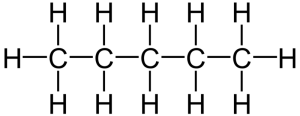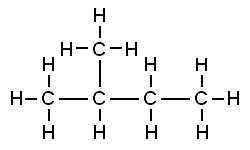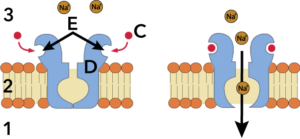

[i]The following quiz will show you the structural formulas of each of the functional groups. Some of the questions will ask you to write in the name, hangman style. Others questions will be multiple choice.
[q]This functional group is
[Qq]
[q]This functional group is
[Qq]
[q]This functional group is
[Qq]
[q]This functional group is
[Qq]
[q]This functional group is
[Qq]
[q]This functional group is
[Qq]
[q]This functional group is
[Qq]
[q]This functional group is
[Qq]
[q]This functional group is
[Qq]
[q]This functional group is
[Qq]
[q]This functional group is
[Qq]
[q]This functional group is
[Qq]
[q]This functional group is
[Qq]
[q]This functional group is
[Qq]
[q]This functional group is
[Qq]
[q]This functional group is
Three of the functional groups, carboxyl, amino, and phosphate can be shown in an ionized or unionized form. You should be able to recognize both forms when you see them attached to molecules. Study the table below.
| Name | Non-ionized form | Ionized form |
| Carboxyl | ||
| Amino | ||
| Phosphate |
In the last tutorial, we saw how carbon can covalently bond with itself and atoms of other elements to form chains, rings, and branched molecules. Carbon’s versatility in forming bonds allows for molecules that have the same number and types of atoms, but which have different structures. For example, the two molecules below are both variations of the formula C5H12. That makes them isomers: molecules with the same number and types of atoms, but with different structures.
| Chain | Branched molecules |
 |  |
There are three types of isomers to know about.
Structural isomers are the kind shown above.
Both of these molecules have the same molecular formula (C5H12), but their structural arrangement differs. The different arrangements can have the effect of giving these molecules different physical and chemical properties.
The second type of isomer is a cis-trans isomer. Cis-trans isomers are the result of the fact that double bonds (two shared pairs of electrons) are geometrically fixed, and don’t allow the atoms they join to rotate around the bond axis. Take a look at these two molecules, both of which have the formula C4H8.
| C4H8, cis configuration | C4H8, trans configuration |
Note how the two methyl groups in the molecule on the left are on the same side of the double bond. That’s referred to as a cis configuration. The cis prefix means “the same,” as in cisgender. People who are cisgender have the same sexual identity as the one they were assigned at birth. Same side, same gender: that’s how you remember the cis configuration.
In the molecule on the right, the two methyl groups are on opposite sides of the double bond, which is referred to as a trans configuration. The trans prefix means “on the other side.” People who are transgender have a different sexual identity than the one they were assigned at birth. A trans-Atlantic crossing takes you across the Atlantic ocean.
 Results in a kink in the otherwise straight chain. Described under heading 4. Isomers." width="443" height="76" />
Results in a kink in the otherwise straight chain. Described under heading 4. Isomers." width="443" height="76" />
As with structural isomers, the different locations of the atoms or functional groups around the double bond can alter the chemical and physical properties of the molecule. For example, you might have heard about trans fatty acids. Fatty acids make up fats and oils. Fatty acids in the trans configuration are associated with heart disease. We’ll learn more about that when we learn about the chemistry of fats and oils in another tutorial in Unit One.
The last type of isomers are molecules are enantiomers. These are isomers that are non-superimposable mirror images of one another. If that sounds abstract, just hold your hands out in front of you. Your hands are analogous to enantiomers: same bones, same digits, with a mirror image structure. If you made a mold that perfectly fit your right hand, your left hand wouldn’t be able to fit into it.
The two molecules below are both chemical relatives of the neurotransmitter dopamine.
Neurotransmitters are the chemicals used to send signals from one nerve cell to the next. Dopamine works in the brains of animals (including humans) in a variety of processes, including reward and movement regulation.
D-dopa and L-dopa look pretty similar, right? Let’s focus on the structural formulas. Remember that in this type of structural formula, every angle vertex indicates a carbon atom. Note that the amino group in D-dopa is shown as being attached to its carbon with a dashed wedge. That dashed wedge means that the amino group is below the plane of the molecule. In L-dopa, there’s a solid wedge connecting the amino group to its carbon. That solid wedge indicates that the amino group is above the plane of the molecule.
 Cell membrane model with a receptor proteins for neurotransmitters. Described under heading 4. Isomers." width="300" height="139" />
Cell membrane model with a receptor proteins for neurotransmitters. Described under heading 4. Isomers." width="300" height="139" />
That difference might seem trivial, but it makes these molecules as different (and as non-interchangeable) as your left and right hands. That’s because neurotransmitters (represented by “3” on the right) work by binding with receptors (E) on cells. In the same way that you can’t put a right-handed glove on your left hand, a receptor that can bind with L-dopa can’t bind with D-dopa. The consequence is that L-dopa can serve as a medicine for people with Parkinson’s disease, a condition where the brain produces insufficient amounts of dopamine. D-dopa has no pharmacological use.
That’s about all you need to know about functional groups and isomers to succeed in an AP Bio course. When we study proteins (as well as other key biological molecules) in the next module of our course, you’ll see that it will be useful to be able to identify functional groups and to hold in mind which ones are polar, non-polar, acidic, basic, and so on. In the quiz that follows, just to keep you on your toes, some of the functional groups shown below are in their ionized form, but others are not. Enjoy!
Click here to start quiz[qwiz qrecord_id=”sciencemusicvideosMeister1961-Functional Groups and Isomers (2.0)”]
[h]Functional groups and isomers
[q]In the diagram below, a hydroxyl group is shown at